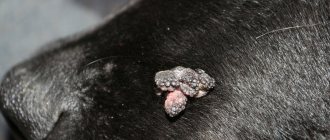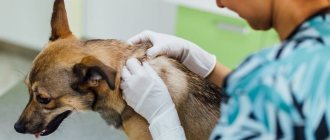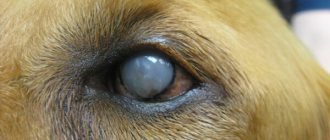According to statistics, after the 10th year of life, about 30% of males and 50% of females suffer from cancer. Cancer in dogs is essentially the same as cancer in humans; it is also uncontrolled cell growth caused by a mutation at the DNA level. Sometimes there are benign formations, but more often the neoplasms are malignant. The gene mutation begins in one cell but spreads to numerous cells, which begin to form tumors as the disease progresses. And lymph and blood transport diseased cells to other organs, where they give rise to daughter formations - metastases. To help your dog in time, you need to pay attention to the following symptoms:
- any bulge or bump-like formation on any part of the dog’s body;
- ulcers that do not heal for a long time;
- the dog has lost its appetite;
- the appearance of blood or pus in places of physiological openings;
- difficulty breathing, discharge of feces and urine;
- the appearance of bad breath;
- difficulty swallowing food or water;
- vomiting and diarrhea;
- difficulty walking, pain;
- the appearance of cough or wheezing; weakness, anemia, pain, sleep disturbances, coordination problems, fainting.
Causes of the disease
No one yet knows the reliable causes of oncological tumors. It is believed that the following reasons are the factors that “trigger” the process of formation and development of pathological cells:
- Stress.
- Excessive insolation.
- Poor nutrition.
- Poor environmental conditions.
- Toxins that enter the body with water, food, and medications.
- Bad habits.
- Radiation.
- Exposure to heavy metals and much more.
Old and weakened animals are more susceptible to diseases than others, although cancer is not selective and affects both older dogs and young and strong dogs, and even puppies.
Most often, the following forms and types of malignant neoplasms occur in dogs:
- Lymphoma.
- Malignant histiocytoma.
- Angiosarcoma.
- Mammary cancer.
- Mast cell tumor.
- Melanoma.
- Osteosarcoma.
- Prostate cancer.
- Transitional cell carcinoma.
Each type of this disease has its own specifics and requires a special method of treatment, the use of specific medications.
What to do and how to treat!
If the initial diagnosis is confirmed, the doctor resorts to mastectomy.
The mammary gland is removed. Often, regional lymph nodes are removed at the same time.
Treatment is carried out in the form of surgery.
Surgery is possible only in the absence of chronic pathologies
. Otherwise, the four-legged client is considered inoperable.
Chemotherapy
If the disease has developed to stages 3-4, then the dog is prescribed a chemotherapy course. Treatment should be systematic. This allows you to suppress the growth and division of cancer cells.
Chemotherapy is prescribed if the disease begins to progress.
In some cases, removal of the ovaries
. But there is no evidence of the effectiveness of this method yet.
Drug therapy
If distant metastases are detected, the doctor prescribes palliative therapy. This can significantly improve the pet’s quality of life. To relieve painful symptoms, the following are used:
- painkillers;
- anti-inflammatory drugs;
- antibacterial drugs.
Painkillers are used to relieve symptoms of the disease.
Hormone therapy
Some veterinarians use Tamoxifen. But the effectiveness of hormonal therapy has not yet been thoroughly studied. No detailed studies have been conducted. The final conclusion will be made after additional research.
In some cases, veterinarians recommend the drug Tamoxifen for treatment.
Symptoms
Oncological neoplasms are dangerous because in the first stages the disease occurs without pronounced symptoms. But an experienced and attentive owner can note the following deviations in the behavior or appearance of the animal:
- Digestive disorders - vomiting after eating, an unexplained decrease in appetite, strange behavior after eating, allowing one to suspect that the dog is suffering from pain. Constipation and diarrhea may be an indication of the presence of cancer in the gastrointestinal tract.
- Problems with urination and bowel movements may be caused by a tumor of the prostate or rectum.
- Coughing, bleeding from the mouth, the feeling that the dog is choking on food and water most often occur with damage to the lungs and other respiratory organs, cancer of the larynx, tumors of the jaw, tongue, lip, nose.
- Changes in gait, unsteady, uncertain movements, and lameness indicate damage to the skeletal system.
- Growths under and on the skin and changes in pigmentation can be symptoms of various types of cancer, including skin cancer.
- Pain - the dog may suffer greatly from pain in the affected parts of the body, as well as from general intoxication, which is expressed by severe weakness, exhaustion and apathy.
- An unpleasant odor emanating from the animal or from individual areas affected by the tumor. Usually indicates the disintegration of a neoplasm, often accompanies breast cancer, lesions of the mouth, and skin.
Depending on the stage of the oncological process, manifestations can be pronounced or subtle, with inflammation of the lymph nodes in the general process and metastases in the terminal stages of the disease.
Diagnostic methods
When examining a dog, the location of the formation, its size, consistency and connection with surrounding tissues (free movement or fusion), the condition of the skin and lymph nodes are taken into account.
In addition, for diagnosis the following is carried out:
- general radiography;
- ultrasound diagnostics;
- general and biochemical blood test;
- detection of tumor markers in the blood.
Important! In most cases, lumps on a dog's body are not a tumor. This may be an abscess (a cavity filled with pus that is painful and hot to the touch), a hematoma (a collection of blood that is bluish in color), or lymphatic drainage (a collection of lymph due to damaged blood vessels).
In this case, special attention is paid to liver enzymes: in the event of inflammation or other pathologies of the liver, chemotherapy can cause serious complications and even death of the dog.
One of the main methods for determining the type of tumor is a biopsy, which is taken using a needle and scraping. It allows you to determine the nature of the tumor and select the optimal treatment.
Diagnostics in a veterinary clinic
In order to detect oncological diseases, an experienced specialist and a laboratory of the appropriate level are required. After a visual examination, the veterinarian will refer the dog for examination and prescribe laboratory tests.
A blood, stool and urine test will be required, depending on the type of disease, to exclude other problems, ultrasound diagnostics, and radiography if there is a suspicion of a process in the bones or metastases in them.
If it is difficult to identify the cause of the disease, the dog is sent for computed tomography or magnetic resonance imaging. Not all clinics can do this, so diagnosing cancer in dogs has its own difficulties, especially in small settlements in the outback.
General information
Human cancer is practically no different from animal cancer - it is a non-contagious cellular mutation that occurs at the DNA level. In recent years, many researchers have confirmed the “single cell theory.” According to this theory, terrible changes suddenly occur in a single cell and it “forgets” its functions. Over time, by dividing the mutated cells become more and more numerous, they form into groups - tumors, and into daughter formations - metastases. For example, breast cancer in dogs often leads to the formation of metastases in bone or lung tissue, in the liver or kidneys.
Gradually, the tumor grows, replacing and displacing healthy cells of the organ. Because cancer cells do not “remember” their functions, the organ stops working properly. In addition, the tumor physically compresses adjacent tissues, which leads to even greater inhibition of performance. When the neoplasm begins to decompose, necrosis, bleeding, ulceration and other signs of tissue breakdown are detected.
Owners often wonder whether dogs have cancer of one or another organ. Unfortunately, animals suffer from all types of cancer to which humans are predisposed. Mostly old animals suffer from cancer, but sometimes young animals aged 1-3 years, most often females, suffer. There is no universal cure, because... cancer is a general name for various types of mutations, i.e. several different diseases. You can support your dog with folk remedies, but only a veterinarian should treat it!
Contrary to popular belief, most types of cancer can be defeated once and for all. But provided that the disease is detected at an early stage, and the veterinarian is an oncologist, and not a regular therapist.
It is impossible to say for sure how long dogs with cancer live - it depends on many individual factors. If cancer cells are not too active, and the disease is detected at an early stage, a complete cure or a full life for many years is possible. Much depends on the location of the tumor - the diseased kidney can be removed, but surgery on the story’s brain is not always possible. Therefore, the veterinarian will answer this question only after a thorough examination and monitoring of the dynamics of the disease.
Treatment method and prognosis
Treatment of cancer patients is almost the same for both people and animals. It is always complex and consists of the following stages:
- Surgical removal of the tumor. The neoplasm must be removed with a part of healthy tissue in order to protect against possible penetration of cancer cells into surrounding tissues and spread of the process.
- Irradiation using a special device. This is not possible in all veterinary clinics. The method is not used for all types of cancer tumors and is not applicable for some types of tumor localization.
- Chemotherapy. It involves taking toxic drugs that can kill cancer cells, destroy or reduce tumors and metastases, and also prevent their formation and further spread.
You cannot give your dog medications intended for humans, since, despite the general principles of the effect on tumors, the type of medication, dosage and intensity of treatment can only be selected by a veterinarian. This is because the dose is calculated only for the individual dog, taking into account his weight, age, general health and the presence of additional problems.
If the doctor prescribes painkillers, there is also a danger of overdose. Owners should obtain full advice from a specialist on how they should act in certain situations.
Treatment of any form of cancer is extremely complex, lengthy and expensive. However, there are some types of this terrible disease that are easier to treat than others and can be cured completely or give long-term remission. These include skin cancer in the early stages.
If the tumor was small, the affected area was insignificant, the stage was early, without the formation of metastases, then the dog has a good chance of recovery.
Types of tumors
Benign tumors are characterized by slow growth, and their negative impact on the body mainly consists of compression of surrounding tissues. They do not form metastases, and after removal they do not relapse. Some types of benign tumors are capable of malignancy (malignancy).
Benign tumors include:
- Adenoma.
- Lipoma.
- Neuroma.
- Osteoma.
- Rhabdomyoma.
- Fibroma.
- Chondroma.
- Epithelioma.
Malignant tumors, if untreated, almost always lead to death: they cause severe intoxication of the body, growing into nearby organs, nerves and blood vessels, destroying them. Most cancerous tumors are capable of recurrence and the formation of metastases, and “daughter” tumors can arise in any area, even remote from the main tumor.
Main types of malignant tumors:
- Glioma.
- Carcinoma.
- Lymphoma.
- Leukemia.
- Melanoma.
- Sarcoma.
What to do at home
Caring for a sick animal must be especially careful, especially if it is undergoing chemotherapy or radiation. During this period, drafts and dampness pose a particular danger, as pneumonia can very quickly kill the dog. This is due to the fact that his defenses and immunity are practically killed by the disease and specific medications.
The dog needs to be provided with a warm, quiet, shaded place and constant access to clean drinking water. Since her fur may fall out, her corner needs to be brushed frequently. If the doctor has prescribed any medications, then they must be given strictly according to his instructions.
If the animal is after surgery, caring for it is exactly the same as after any other surgical intervention. The seams must be carefully treated with special disinfectant compounds; if redness, blood, pus appears, or if the animal is restless, you must immediately call a veterinarian.
After surgery, your dog needs to eat well to speed up recovery and strengthen its weakened immune system. The doctor will give the necessary feeding recommendations depending on which organs have been affected by cancer. There are some subtleties and restrictions in feeding if the dog has had cancer of the digestive or excretory organs.
Cancer is terrible because it causes incredible suffering to patients. If it becomes obvious that there is no hope for recovery, and the dog is in great pain, it would be much more humane to end its suffering.
Symptoms of uterine cancer in dogs
- depression, sharp deterioration in general condition;
- fatigue, drowsiness;
- anemia of the mucous membranes;
- uterine bleeding, copious mucopurulent discharge from the vagina;
- frequent urge to urinate, painful urination;
- severe pain on palpation of the peritoneum;
- infertility;
- increase in abdominal volume;
- unstable stool, painful bowel movements;
- loss of appetite, refusal to feed;
- increased thirst;
- enlarged inguinal lymph nodes;
- weight loss, exhaustion, intoxication;
- change in the color of urine, the presence of bloody inclusions, threads, clots in it.
Important! Signs and the intensity of their manifestation depend on the location, size, nature, histology of cancerous formations, and the stage of development of the oncological process.
As a rule, the first manifestations are clearly noticeable when the tumor increases in size, reaches a certain size and begins to compress nearby organs (bladder, intestines).
Uterine bleeding in cancer can occur periodically after physical exertion and can be short-term or long-lasting. In advanced cases, pale pink exudate is constantly released from the external genitalia. Dogs may experience severe pain when moving, so activity is limited to a minimum.
Tumors in the uterus have the appearance of single, limited formations of a spherical shape, inside of which there is a cavity formed due to necrosis, the disintegration of dead tissue. Diffuse tumors are rare in females.
Possible complications
With cancer, the most dangerous complication is metastases, leading to the spread of cancer throughout the dog’s body. This leads to a generalization of the process, which is expressed by increased intoxication. If organs such as the brain, lungs, liver and, less commonly, the heart are affected, the dog’s fate is predetermined. The duration of her remaining life is calculated in months, and sometimes weeks.
Bone lesions lead to pathological fractures that do not heal. Problems with the digestive system are extremely exhausting for both the dog and its owners. She literally melts before our eyes, practically dying from exhaustion.
Since cancer is treatable only in the first two stages, in the presence of terminal stages there is no talk of recovery. You can only provide your pet with a calm, painless last days of life, surrounded by loving and caring owners.
Diagnostic features
To clarify the diagnosis, the veterinarian prescribes the following:
- X-rays.
- Biopsies.
- Cytology.
- Aspiration.
To make a diagnosis, radiography is prescribed.
- Using X-ray examination
, metastases are detected in the lungs and lymph nodes. Ultrasound reveals tumors in the abdominal cavity. - Breast secretions
are sent for microscopic analysis. - Aspiration and cytology can reveal inflammation
. And these diagnostic methods also help determine the type of tumor and how sensitive it is to the effects of medications. - The most effective and informative diagnostic method is histological analysis
. It allows you to determine the nature of the detected tumor. - The stage of the pathology is determined by the size of the tumor
. But the absence or presence of metastasis is also taken into account. In addition, the specialist undertakes to assess the extent of damage to nearby organs. - If so, an x-ray of the paw
. This will help determine the presence of bone metastases.
The symptoms of diffuse cancer resemble those of mastopathy.
In order to clarify the diagnosis, differential diagnosis is prescribed.
Prevention measures
There are no preventive measures against cancer as such. However, you can monitor the health of your pet. It is important to provide him with good, high-quality and balanced nutrition, a healthy lifestyle, timely treatment and excellent care.
To prevent cancer, you need to avoid risk factors, for example, not keeping your dog in direct sunlight. It has been proven that malignant melanoma occurs much more often with regular intense radiation, especially with sunburn.
Hairless and short-haired dogs are more susceptible to this than others, especially those with light skin and hair. White dogs and cats often have pink noses, which are very affected by the sun's rays. With repeated burns, the risk of cancer increases several times.
Although exposure to the sun is good for your animal's health, keeping it in direct sunlight is very dangerous. In hot countries, light-colored dogs should wear hats if they go out on the beach or on long walks. By the way, the local population has long been practicing such methods, supplying horses and donkeys with straw hats.
There are a number of studies that suggest that enriching food with vitamins and antioxidants reduces the risk of developing malignant tumors. In any case, you should always consult your veterinarian before taking any steps.
Clinical manifestations
Cancers in the uterus can be benign or malignant.
Dogs are diagnosed with:
- Myomas. Benign tumors that form in the muscle layer.
- Leiomyoma. The tumor is benign, formed from smooth muscle structures.
- Fibroids. Tumor formations of muscle and connective tissue.
- Leiomyosarcoma. Cancer of the smooth muscles of the organ.
Benign cancerous tumors do not put pressure on nearby tissues. Their growth occurs locally. The pathological process develops slowly. At the onset of the disease, symptoms are absent or mild.
Malignant neoplasms in the uterus can be in the form of fibrosarcomas, sarcomas. Characterized by a fast flow and aggressive nature. They often metastasize to the liver, spleen, lungs, and stomach.











